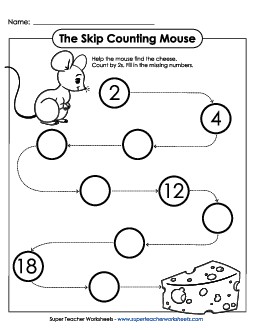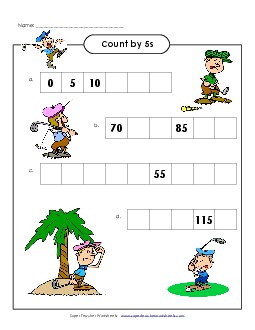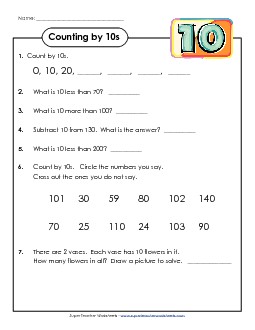Skip Counting Worksheets

This page features several free skip counting worksheets for teaching students to count by twos.
Skip Count by 3sUse these sheets to help students learn to count by threes.
Skip Count by 4sThese worksheets will help you teach pupils to count by intervals of four.
Skip Count by 5sPractice skip counting by fives with these free worksheets.
Skip Count by 6sUse these skip counting worksheets for teaching your students to count by sixes.
Skip Count by 7sLearn to skip count by sevens with these printable pages.
Skip Count by 8sSkip count by eights with fun printable worksheets.
Skip Count by 9sYour students will learn to skip count by nines with these printable worksheets.
Skip Count by 10sThese printables will help you teach your students to count by tens.
Skip Count by 11sSkip count by 11s with these graphical worksheets.
Skip Count by 12sPractice skip counting by 12s with these printable worksheets.
Skip Count by 25sThese free printables will help you teach your students to count by twenty-fives.
Skip Count by 100sThese printables will help you teach your students to count by hundreds.
Hundreds ChartHundreds charts are useful tools for teaching counting, skip counting, and place value skills.
Numbers and Counting (Basic)For young students, who are learning to count to 10, 20, 30, or 100, this collection of worksheets and activities may help.
Counting Worksheets (Advanced)If you're teaching students to count by ones backwards and forwards, try these two, three, and four digit counting worksheets.
Multiplication WorksheetsMultiplication and skip-counting go hand-in-hand. If your students have mastered skip counting, basic multiplication facts will be a breeze.



Skip counting is an important elementary school math skill that helps students build a foundation for more advanced arithmetic concepts, such as multiplication and division. Typically introduced in kindergarten and reinforced in first and second grades, skip counting involves counting forward by numbers other than one, such as by 2s, 3s, 5s, or 10s. For example, when skip counting by 2s, students would count 2, 4, 6, 8, and so on. This process helps students recognize patterns in numbers and makes it easier for them to grasp multiplication tables, addition shortcuts, and even concepts like grouping and estimation.
Teachers use various methods to help students master skip counting. Visual aids like number lines, hundreds charts, and counters are available on Super Teacher Worksheets and can make it easier for students to see the patterns that emerge as they count by different intervals. Interactive activities, such as clapping or stepping as they count by 5s or 10s, provide a kinesthetic approach that helps reinforce the skill. Additionally, songs, chants, and games are effective tools that make skip counting fun and engaging, while worksheets and apps offer practice in recognizing number sequences. By frequently revisiting and practicing skip counting, students develop fluency with numbers, which is essential for understanding multiplication and division concepts introduced in later grades.
Mastering skip counting is crucial for students’ success in math, as it lays the groundwork for more advanced arithmetic skills. Skip counting is often used as an introduction to multiplication, as students learn that counting by 5s, for example, is the same as multiplying by 5. It also strengthens number sense, helping students develop an understanding of patterns and relationships between numbers. Skip counting is a practical skill used in everyday situations, such as counting money, telling time, or organizing objects. A solid grasp of skip counting enables students to move through more complex math problems with ease, making it an essential part of their early math education.






